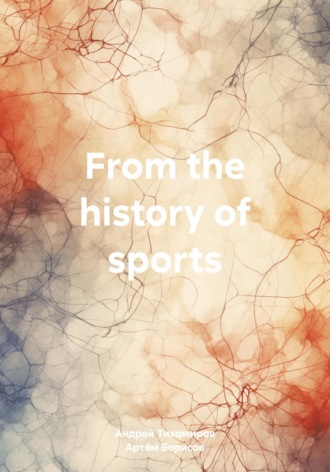
Андрей Тихомиров
From the history of sports
The concept of sports and physical education
Sport (from the original Old French word disport – game, entertainment, leisure) and physical culture are part of the general culture of society, including a system of physical education of people, as well as a set of sporting achievements, special scientific knowledge and technical means. Sport is understood as physical exercise, which aims, along with strengthening health, developing physical strength and motor abilities, to achieve victory or high results in competitions (for example, setting a record); the choice of physical exercises is subordinated to the solution of this task. There are a large number of sports (running, skiing, ice skating, horse riding, cycling, wrestling, rowing, etc.) for which stable rules have been developed governing the conduct of competitions, as well as the conditions and procedure for fixing the results achieved and determining the winners.
The existence of competition rules that are mandatory for all participants, the desire to win and achieve the highest sporting results in competitions, as well as the struggle for personal honor and the honor of the team are characteristic of each sport. At the heart of some sports are original physical exercises, games and entertainment in the form of folk wrestling, equestrian competitions, running, cultivated from time immemorial among many peoples of the world.
Training is crucial in achieving high results in any sport. Indications and contraindications to playing sports in general and to participating in competitions in certain types are determined not only by the physical development and health of the athlete, but also by the fitness of the body. Training requires strict systematic training, well-thought-out and skilful selection of funds, as well as compliance with the correct training and recreation regime, rules of personal hygiene and food hygiene, clothing, equipment of the athlete.
Sportsmanship is an attitude aimed at fair play, politeness towards teammates and rivals, ethical behavior and honesty, as well as grace in winning or losing.
The key principles of the sport include that the result should not be predetermined and that both sides should have equal opportunities to win. There are rules to ensure fair play, but participants can break these rules to gain an advantage.
Participants may cheat to unfairly increase their chances of winning or to achieve other benefits such as financial gain. The widespread use of gambling on the results of sporting events creates motivation for match-fixing, when a participant or participants intentionally work to ensure a given result, and not just play to win.
The competitive nature of the sport encourages some participants to try to improve their results with medication or other means, such as increasing the volume of blood in their body artificially.
All sports recognized by the International Olympic Committee (IOC) are required to conduct a testing program for the presence of a list of prohibited drugs, while participants who test positive for prohibited substances are suspended from the competition.
Violence in sports involves crossing the line between fair competition and deliberate aggressive violence. Athletes, coaches, fans, and parents sometimes show violence towards people or property, mistakenly demonstrating loyalty, dominance, anger, or triumph. Riots or hooliganism by fans, in particular, are a problem at some national and international sports competitions.
Youth sports provide children with opportunities for entertainment, socialization, forming relationships with peers, physical training and sports scholarships. Activists for education and the war on drugs promote youth sports as a means of increasing participation in education and combating the illegal drug trade. According to the Center for Injury Research and Policy at the National Children's Hospital, the greatest risk to youth sports is death or serious injury, including concussion. These risks are associated with running, basketball, association football, volleyball, sports netting, gymnastics and ice hockey.
Sports for the disabled, also adaptive sports or para—sports, are sports that people with disabilities, including physical and intellectual disabilities, engage in. Because many of them are based on existing sports modified to meet the needs of people with disabilities, they are sometimes referred to as adapted sports. However, not all sports for the disabled are adapted; some sports that were specifically created for people with disabilities do not have an equivalent in sports for the able-bodied population.
The element of competition in sports, along with the aesthetic appeal of some sports, leads to the popularity of people attending sports. This led to the emergence of a specific phenomenon of sports with spectators.







